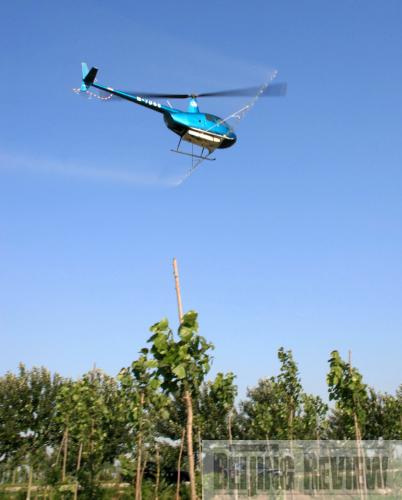|
 |
|
TERMINATE THEM!: A helicopter sprays insecticide on June 24 over a Luannan County forest in Hebei Province to prevent the spread of the American white moth (ZHANG YONGXIN) |
Alien invaders are pouring through China's borders, taking up residence on land, water and air and stressing residents that for millennia have called this part of Asia home.
But the invaders are neither part of some mechanized army nor are they even human—they are the plants, animals and microorganisms that have found in China conditions where they can thrive, often out-competing native species and leaving economic, health or environmental damage in their wake.
But China is not alone in its battle to curb the movement of alien species into its territory; the problem is global. It has become such a pressing issue that the UN proclaimed it this year's theme during the International Day for Biological Diversity, which fell on May 22.
The day provided an opportunity for those countries and regions that are dealing with invasive alien species to raise awareness of the issue and increase action to tackle the problem, said Xie Yan, an associate research fellow with the Chinese Academy of Sciences' Institute of Zoology.
Xie said invasive alien species are those organisms that are not native to an ecosystem. They can adversely impact biodiversity by decreasing or eliminating native species through competition, predation or transmission of pathogens, and they can disrupt local ecosystems and their proper functioning.
A big threat
Invasives are causing enormous economic losses in China and seriously affecting people's lives, said Wang Jie, Director of the Office of Bio-Safety Management at the Ministry of Environmental Protection's Department of Nature and Ecology Conservation.
Wang said China is one of the countries most affected by invasive species, so far documenting more than 280 non-native organisms. More than half of the 100 dangerous alien species listed by the World Conservation Union have been found in China.
China is vulnerable to invasion by alien species, said Xie. The country spans from north to south 50 degrees of latitude and covers five climate zones ranging from the temperate to subtropical and tropical regions.
"Given the high variety inherent in China's geography, most foreign species from around the world can find suitable habitats here," Xie said.
Wang said that, according to 2003 research, the economic losses caused by invasive alien species in China amounted to 120 billion yuan ($18 billion), accounting for 1.36 percent of the gross domestic product that year.
Current yearly losses caused by invasives are as high as 200 billion yuan ($29 billion) in China, with the situation expected to get worse, said Wang.
According to a World Conservation Union report, annual global economic losses caused by invasive alien species amount to more than $400 billion.
The problem is more than one of economics, though. Xie said invasive species may cause damage to agriculture and forestry, the extinction of native plants and animals, huge losses of local biodiversity and even the disruption of genetic inheritance in some rare indigenous species, which can sometimes crossbreed with foreign counterparts.
"Canada goldenrod and ragweed, two plants native to North America, are two examples," said Xie. Research shows that Canada goldenrod is responsible for the destruction of 30 types of plants after it was discovered in Shanghai in 1935. Ragweed has been quickly spreading in China from south to north in the past 70 years, sterilizing arable land and reducing crop output by over consuming much of the nutrients in soils.
"It's horrible that 46 percent of invasive alien species in China have intruded into nature reserves," said Wang.
| 